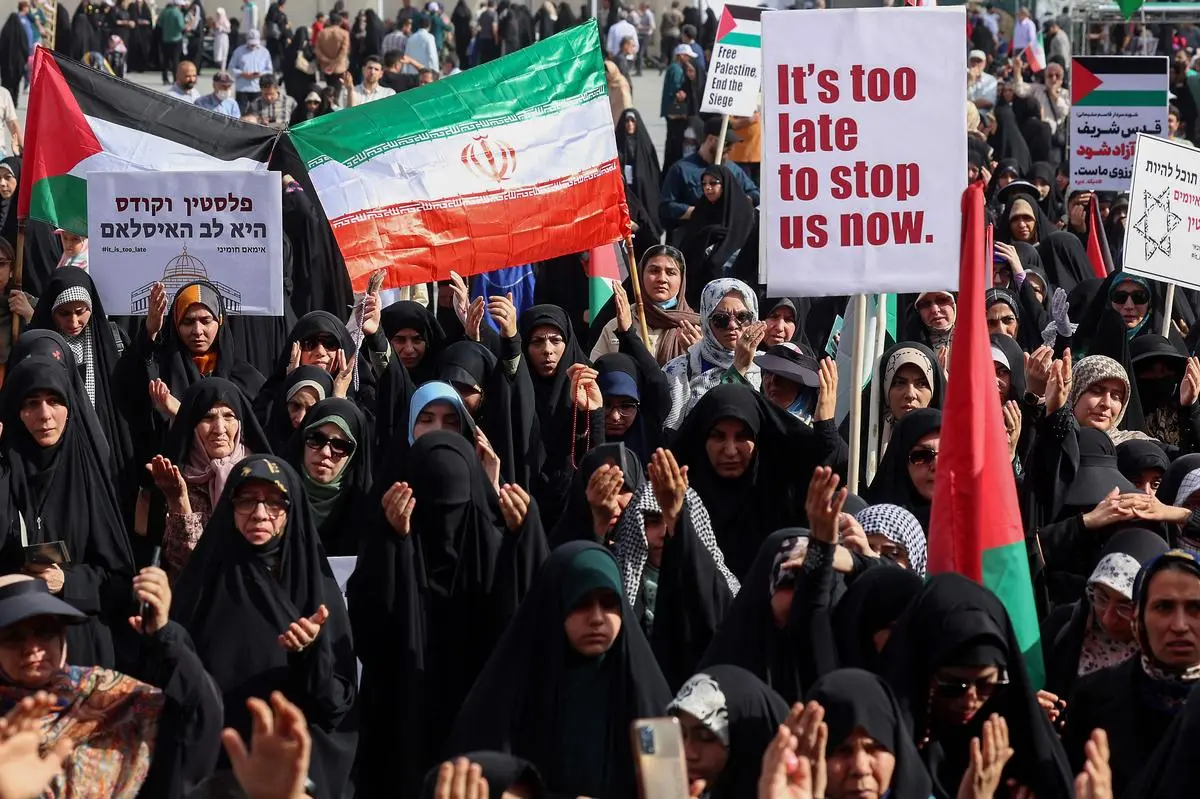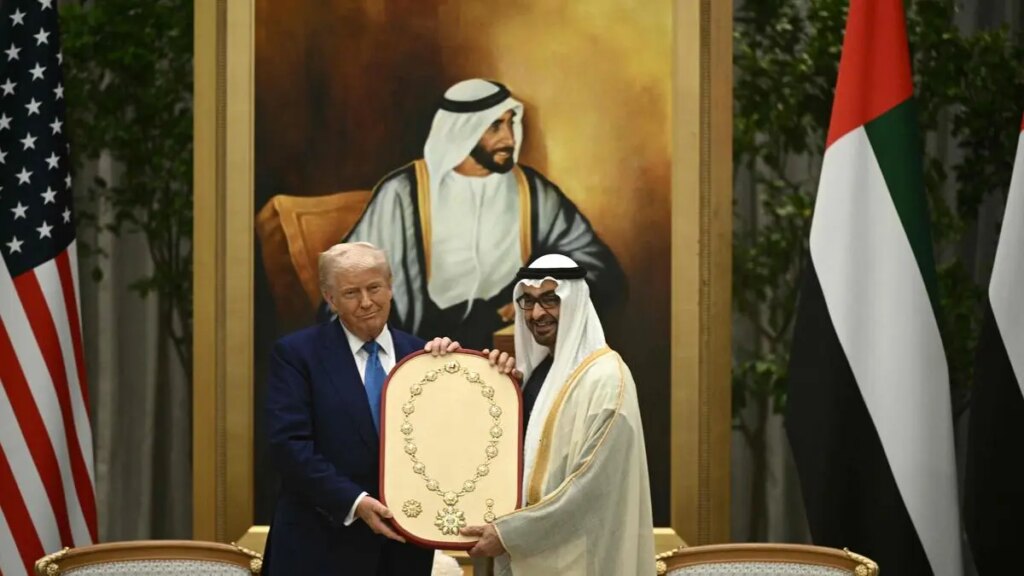Two contrasting images emerged from West Asia in recent weeks. One was the escalated destruction of Gaza by Israel and the imminent danger of starvation in the Palestinian territory. The other was the pomp and glitter of parades, extravagant dinners, and sumptuous deal-making in the capitals of Gulf monarchies during President Donald Trump’s visit to the region in mid-May 2025. Trump’s visit to Saudi Arabia, Qatar, and the United Arab Emirates emphasised the significance of the Gulf region for the United States’ economic and strategic calculus.
As in his first term, Trump chose the Gulf region as the destination for his first official visit abroad. That preference emerges from his personal equations with the monarchs of the region and from the consideration that only these countries have the potential to offer business deals of huge magnitude. The visit is regarded as a big success in business terms, but it has fallen far short of achieving anything substantial in the Israel-Palestine front as the genocide in the Gaza Strip shows no sign of ending soon.
The political front
President Trump asserted his business-like status-quoism regarding the nature of Gulf politics and his endorsement of the monarchs and their ways of conducting affairs of the state. There was no preaching of values of democracy or the American way of life. While addressing the investment meet at Riyadh, he pointed out that the “great transformation [of the Gulf states] has not come from Western intervention or flying people in beautiful planes, giving you lectures on how to live and how to govern your own affairs”. The rulers of the Gulf monarchies would have been happy with such a system-supporting assurance from President Trump.
Also Read | Explained: Trump’s executive order on gain-of-function research
The sidelining of Israeli Prime Minister Benjamin Netanyahu in the planning and conduct of Trump’s visit has been an important news item that was projected worldwide through diverse sets of media. The non-inclusion of Israel in this West Asia trip, unlike in his first-term visit, stood out. The Netanyahu government’s violation of the Israel-Hamas ceasefire agreement, which had been arrived at just in time for the inauguration of Trump’s second term, was seen as a blow to the US President’s calculations in the region.
Netanyahu was not happy with the Trump administration negotiating with Iran on the nuclear issue. Also, the usual US consultation with Israel on major West Asia initiatives and visits did not happen this time. The release of the US hostage Edan Alexander through Steve Witkoff’s negotiations with Hamas, with the mediation of Qatar and without any involvement of Israel, was widely seen as a demonstration of American diplomatic effort independent of Israel.
All this does not mean US military and political support to Israel diminished in any recognisable manner. As in President Joe Biden’s term, the US under Trump continues to arm Israel in its conduct of genocide in Gaza. Trump has been equating pro-Palestinian resistance in the US with “anti-Semitism” and has been using it to suppress student activism in US universities. It is also used to pursue his aggressive anti-immigration policy.
A significant political development was Trump’s meeting with the Syrian interim President, Ahmad al-Sharaa, and his promise of lifting American sanctions against Syria—a major departure from earlier US policy. Many of Trump’s officials reportedly got to know about the move only at the last minute. The Israeli government seems to have had no prior knowledge of the move.
Business deals
The signing of big business deals between the three Gulf monarchies and the US was a major aspect of Trump’s visit and was highlighted by the American media. Trump successfully projected his trip as one that brought unprecedented investments to the US, thereby paving the way for the creation of thousands of jobs. He even got praise from some Democrats who were otherwise critical of his domestic policies.
Trump was accompanied by more than 30 US business leaders who could extract lucrative deals through President Trump’s leadership in the negotiations. Most of these business houses had contributed heavily to Trump’s election fund, and more so for his inauguration fund, thereby earning a spot in his delegation.
A White House statement on the trip said: “President Donald J. Trump’s first official trip was a huge success, locking in over $2 trillion in great deals—including a $600 billion investment commitment from Saudi Arabia, a $1.2 trillion economic exchange agreement with Qatar, $243.5 billion in US-Qatar commercial and defense deals, and $200 billion in US-United Arab Emirates commercial deals.” The White House also showcased a compendium of statements of the CEOs and other business leaders on the deals and the share of each of their companies in the overall commercial agreements.
Sectors like defence and artificial intelligence (AI) had a prominent place in the business agreements. Saudi Arabia agreed to buy military equipment and services worth $142 billion from various US companies. Qatar agreed to invest $10 billion in the US military base and buy weapons worth $42 billion from the US. Qatar also agreed to acquire drone technology and remotely piloted aircraft from US defence companies totalling $3 billion.
Donald Trump with Saudi Crown Prince Mohammed bin Salman and Syrian President Ahmad al-Sharaa in Riyadh.
| Photo Credit:
SAUDI PRESS AGENCY/REUTERS
In the AI sector, massive to-and-fro investments, relating particularly to military and surveillance uses, were announced. They raise many ethical and political questions and certainly boost these monarchies’ ability to strengthen their domestic control.
The UAE and the US agreed to build a huge AI data centre in Abu Dhabi. Humain, a newly launched Saudi company which is backed by the Saudi Public Investment Fund and Crown Prince Mohammed bin Salman himself, will receive 18,000 AI chips from the American multinational company Nvidia. US tech and aerospace giants—including AMD, Global AI, Cisco, Google, and Amazon—are poised to benefit from potential investments and purchases by Saudi Arabia, Qatar, and the UAE.
In a major deal, Qatar Airways agreed to purchase 210 jets from US manufacturer Boeing. In a separate gesture, Qatar gifted a luxury Boeing 747 valued at $400 million, which Trump accepted for conversion into the new Air Force One. The question of ethics and the conflict of interest involved in accepting such a massive gift did not deter him. The intertwining of personal business interests and those of US companies and the US government has been an important aspect of the visit. Trump’s visit facilitated newer golf-club deals and cryptocurrency exchanges through family-owned firms like World Liberty International.
Trump’s visit and the deals signed during it underline the region’s significance to American interests. The Gulf region hosts US military bases, while the US provides a security umbrella to the Gulf monarchies in the form of protecting oil shipments and ensuring the ruling regimes’ security. The strategic significance of the Gulf was acknowledged by the Richard Nixon administration in the early 1970s itself—the “Twin Pillar Policy” of considering Shah’s Iran and Saudi Arabia as two pillars of American policy in the Gulf, apart from Israel as another pillar in the larger West Asian region. The Iranian Revolution of 1979 upset the arrangement as the Islamic Republic turned hostile to American interests in the region.
When the Gulf Cooperation Council was formed in the early 1980s, the US maintained good relations with the Saudi-led system in the region. The events of September 11, 2001, created a temporary lack of warmth in Saudi-US relations, and Saudi Arabia tried to extend its security cooperation with China, Russia, and India. Yet, the importance of the Gulf region with regard to the protection of US interests did not diminish, and the American security architecture in the region has continued to be valuable for the Gulf states. Trump’s visit contributed to the enhancement of such strategic ties, although the business deals got most of the media attention.
The Iran factor
Trump’s visit took place just before nuclear negotiations between Iran and the US, mediated by Oman, began in Rome. During the visit, Trump even hinted at withdrawal of sanctions against Iran if an agreement was reached on Iran’s nuclear programme. At the same time, he also issued the threat of bombing Iran if negotiations failed. There are many differences to be sorted out, particularly on the level of Iran’s nuclear enrichment.

A rally in support of Palestinians in Tehran on May 2, 2025. Iran, which seeks an end to decades-old sanctions, is in the middle of nuclear negotiations with the US.
| Photo Credit:
AFP
Iranian President Masoud Pezeshkian treads a cautious path in the ongoing nuclear negotiations. Iran wants a lifting of the decades-old sanctions. The country’s Supreme Leader, Ayatollah Ali Khamenei, has publicly shown scepticism with regard to US intentions in the Gulf region. He recently stated that for peace in the region, the US should leave the Persian Gulf. What emerges from President Trump’s visit now is a strengthening of American strategic and economic presence in the region.
Saudi Arabia and Qatar have been trying to engage with Iran in various ways. Saudi-Iran agreements of the recent past, the reopening of embassies in each other’s capitals, and the starting of Saudi airlines’ operations to Tehran showed the expanded mutuality of interests between the Saudis and the Iranians.
Also Read | Trump’s tariff spree could end up fast-tracking China’s rise
Saudi Defence Minister Prince Khalid bin Salman visited Iran just before Trump’s visit. Saudi Arabia and other Gulf countries do not want a US-Iran conflict to escalate into a bombing campaign as that would disrupt the whole region and its oil exports.
Trump’s West Asia trip had enough to satisfy his domestic constituency by promising economic growth and job creation at a time when the US economy is going through a chaotic transformation because of his tariff and immigration policies.
The Gulf regimes and Syria got assurances, on security and sanctions relief respectively, from the US. The biggest gain is for American companies as the series of business deals that President Trump was able to negotiate will enrich them substantially. There was no big push from the three Gulf countries to make the US commit to compel Israel to end the ongoing genocide in Gaza.
A.K. Ramakrishnan is retired professor, Centre for West Asian Studies, School of International Studies, Jawaharlal Nehru University.
Source:https://frontline.thehindu.com/politics/trump-gulf-visit-2025-us-israel-iran-deals/article69606147.ece

